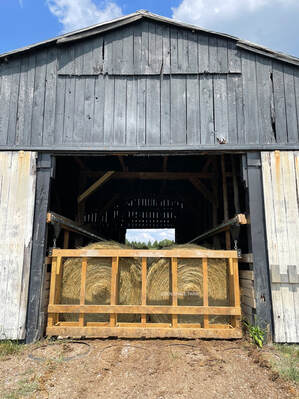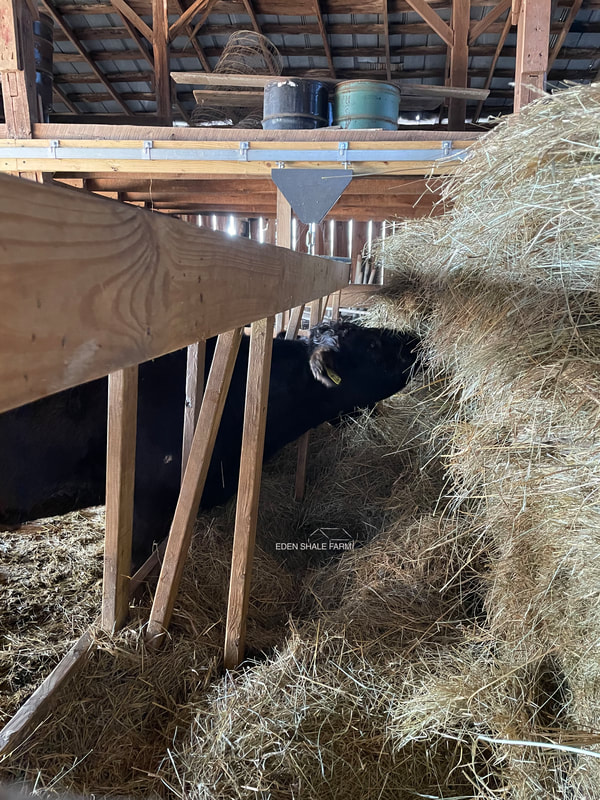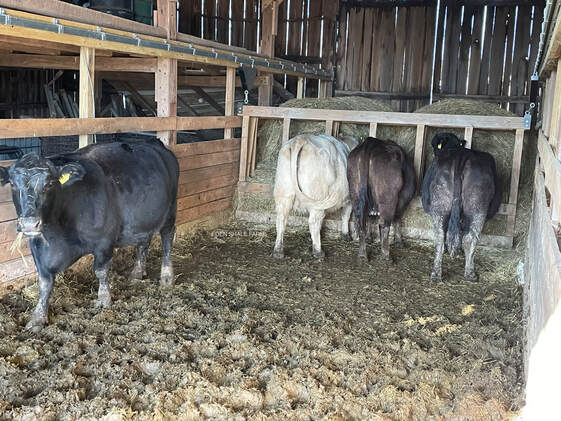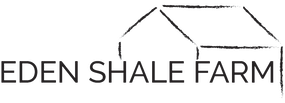|
This month I want to showcase one of the winter feeding structures that we use at the farm. The Barn Alley Feeder is a self feeding hay storage facility that was created by renovating an old tobacco barn. After tobacco production left Eden Shale, the barn was primarily used for extra storage. This barn is located on a 25-acre endophyte free fescue hay field, just around the corner from another winter feeding area which contains the Large Bale Feeder. Unfortunately, there is not enough space at the large bale feeder to accommodate the entire herd. Dr. Higgins proposed a plan to “reprogram” the old tobacco barn into a self-feeding hay system with hay storage. We isolated the barn from the hay field by installing two sections of fence (approximately 300 feet) to create a winter feeding area that includes the barn alley feeder, mineral, and a tire water tank. Cattle currently utilize the joining wooded area in the winter as a shelter-belt, thereby reducing feed and maintenance requirements, and stress on the heavy bred cattle. This self-feeding hay feeder was created by using the existing center alley, support columns, and concrete floor. The feeder design utilizes an under-hung crane concept. This design suspends the feed panel (made of wood) and allows the panel to travel from one end of the barn to the other. Hay is loaded into the barn (strings are removed at the time of storage) from the northern end, while the cattle will access the hay in the feeder from the southern end of the barn. The southern exposure will provide a drier surface for the cattle as well as keeping any snow and ice melted away. The design of the feeder reduces hay waste by creating separation between the cattle and the hay of approximately 20 inches. Also, the feed panel hangs 6 inches above the floor requiring that the cows clean up all the hay before the panel will advance, which is key in reducing the amount of hay waste the cattle create.
The benefit of this layout is that the distance between the hay field and hay storage has been reduced significantly, compared to the previous storage practice. Storing the hay inside also reduces the degradation of the nutritional quality of the hay and eliminates the need to move bales from the previous storage location to the feeder. This eliminates the time, labor, and waste of relocating the bales during winter feeding. This Barn Alley Feeder fed approximately 20 head of cows from December 27th to February 11th. During this time period we did not have to start the tractor, add more hay bales, or fight mud or frozen gates. The cattle simply used this structure to self feed through the 30 bales that were stored in the barn. As you can see, manure buildup was not an issue during this time period. From a whole farm perspective, this project leverages a structure and an area of land to create an organized hub. It creates a permanent feeding location using a fixed structure, which also allows for hay storage. With this project, we were able to repurpose an old facility into production, while implementing labor saving practices. This project has proven to be a cost effective design for reprogramming an existing tobacco barn into winter feeding infrastructure. |
Archives
June 2024
Categories
All
Welcome |
CONTACT US |
EMAIL SIGN UP |
|
Eden Shale Farm
245 Eden Shale Rd. Office: (859) 278-0899 Owenton, KY 40359 Fax: (859) 260-2060 © 2021 Kentucky Beef Network, LLC.. All rights reserved.
|
Receive our blog updates
|




 RSS Feed
RSS Feed
